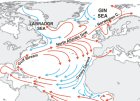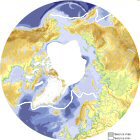
|
The Atlantic heat conveyor |
||||||
|
General Interest
RAPID: The NERC directed programme for rapid climate change research Information for RAPID Stakeholders
The Atlantic Conveyor
|
The ocean circulation - a global system of surface and deep currents - is powered by two different 'engines'. Movement in the top few hundred to a thousand metres is driven mainly by the prevailing winds. Vertical circulation is driven by cold, salty water sinking at high latitudes, returning towards the equator at depth and being replaced by warm water moving towards the poles at the surface. This is known as the thermohaline circulation (or THC) from the combination of temperature (~thermo) and saltiness (~haline) that controls high-latitude sinking. The flow we can measure is a combination both systems - the wind-driven circulation and the THC. It is not possible to measure the THC directly. Instead we can get an idea of its strength by measuring what is known as the meridional overturning circulation (MOC) - the flow at different depths, for the full width of the Atlantic. One of the most important aims of RAPID is to monitor this flow. Why the Atlantic is specialThe Atlantic is the only ocean where heat is transported north across the equator. Here warm surface water from the tropics reaches further north than in anywhere else. The relatively warm, salty water of the Gulf Stream system remains at the ocean surface west of Svalbard to a latitude of about 80 degrees before it dips underneath the much fresher and less dense polar water. The heat released by this warm water makes the climate in regions bordering the eastern North Atlantic warmer than at similar latitudes elsewhere. The results of this warm flow can also be seen in the extent of Arctic Sea ice, which differs markedly from that in the Pacific region of the Arctic. The effect of this Atlantic heat conveyor is most noticeable in winter. The relative warmth of the northern North Atlantic is due to the unique role this ocean plays in the thermohaline circulation. Cold, dense water sinking in the northern North Atlantic drives the Northern Hemisphere loop of the THC. In the Pacific there is no such area where salty subtropical water can travel far enough north and cool down sufficiently to sink. A slow-down in of the North Atlantic loop of the thermohaline circulation may therefore have consequences not just for the North Atlantic region, but for the entire global heat conveyor. How could the THC slow down?The North Atlantic loop of the THC is controlled by the sinking of dense (cold and salty) water at high latitudes. The density of seawater is a result of both temperature and salinity (salty water is denser than fresh water, and cold water denser than warm water). Although the Gulf Stream water is saltier than the deep water below, it is much warmer, so its density is lower, and it remains on the surface. On its journey north, the water releases heat to the atmosphere, and cools gradually, until it is cold enough for its density to match that of the deep layer. Sinking can begin. At this stage the surface water is still warmer than the deep water, but it also saltier, so its density matches that of the deeper water, allowing the two layers to mix. Should the surface water freshen for some reasons, it would have to cool further before it can sink. Sufficient freshwater input might reduce salinity to the extent that the surface water could not possibly sink, even at sub-zero temperatures. Paradoxically global warming could create precisely this effect. Increased rainfall, melting of sea ice, glaciers and the Greenland ice sheet are all possible consequences of higher temperatures, and could reduce North Atlantic surface salinity sufficiently to slow down or even stop the formation of deep water. If this happens, the THC may shut down. Once stopped, the heat conveyor may take time to recover, and the consequences would be a cooling of northwest Europe. |
|
|||||

|
Maintained by Val Byfield Last modified: January 11 2007 17:51 |
||||||





